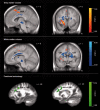Structural neuroplasticity in the sensorimotor network of professional female ballet dancers
- PMID: 20024944
- PMCID: PMC6870845
- DOI: 10.1002/hbm.20928
Structural neuroplasticity in the sensorimotor network of professional female ballet dancers
Abstract
Evidence suggests that motor, sensory, and cognitive training modulates brain structures involved in a specific practice. Functional neuroimaging revealed key brain structures involved in dancing such as the putamen and the premotor cortex. Intensive ballet dance training was expected to modulate the structures of the sensorimotor network, for example, the putamen, premotor cortex, supplementary motor area (SMA), and the corticospinal tracts. We investigated gray (GM) and white matter (WM) volumes, fractional anisotropy (FA), and mean diffusivity (MD) using magnetic resonance-based morphometry and diffusion tensor imaging in 10 professional female ballet dancers compared with 10 nondancers. In dancers compared with nondancers, decreased GM volumes were observed in the left premotor cortex, SMA, putamen, and superior frontal gyrus, and decreased WM volumes in both corticospinal tracts, both internal capsules, corpus callosum, and left anterior cingulum. FA was lower in the WM underlying the dancers' left and right premotor cortex. There were no significant differences in MD between the groups. Age of dance commencement was negatively correlated with GM and WM volume in the right premotor cortex and internal capsule, respectively, and positively correlated with WM volume in the left precentral gyrus and corpus callosum. Results were not influenced by the significantly lower body mass index of the dancers. The present findings complement the results of functional imaging studies in experts that revealed reduced neural activity in skilled compared with nonskilled subjects. Reductions in brain activity are accompanied by local decreases in GM and WM volumes and decreased FA.
2009 Wiley-Liss, Inc.
Figures

Similar articles
-
Differences in Cortical Representation and Structural Connectivity of Hands and Feet between Professional Handball Players and Ballet Dancers.Neural Plast. 2016;2016:6817397. doi: 10.1155/2016/6817397. Epub 2016 May 9. Neural Plast. 2016. PMID: 27247805 Free PMC article.
-
The descending motor tracts are different in dancers and musicians.Brain Struct Funct. 2019 Dec;224(9):3229-3246. doi: 10.1007/s00429-019-01963-0. Epub 2019 Oct 16. Brain Struct Funct. 2019. PMID: 31620887
-
Ballroom Dancing Promotes Neural Activity in the Sensorimotor System: A Resting-State fMRI Study.Neural Plast. 2018 Apr 26;2018:2024835. doi: 10.1155/2018/2024835. eCollection 2018. Neural Plast. 2018. PMID: 29853838 Free PMC article.
-
The role of diffusion tensor imaging and fractional anisotropy in the evaluation of patients with idiopathic normal pressure hydrocephalus: a literature review.Neurosurg Focus. 2016 Sep;41(3):E12. doi: 10.3171/2016.6.FOCUS16192. Neurosurg Focus. 2016. PMID: 27581308 Review.
-
Brain Activity of Professional Dancers During Audiovisual Stimuli Exposure: A Systematic Review.Adv Exp Med Biol. 2023;1425:457-467. doi: 10.1007/978-3-031-31986-0_44. Adv Exp Med Biol. 2023. PMID: 37581819
Cited by
-
Cortico-cortical white matter motor pathway microstructure is related to psychomotor retardation in major depressive disorder.PLoS One. 2012;7(12):e52238. doi: 10.1371/journal.pone.0052238. Epub 2012 Dec 20. PLoS One. 2012. PMID: 23284950 Free PMC article.
-
Individualized goal directed dance rehabilitation in chronic state of severe traumatic brain injury: A case study.Heliyon. 2019 Feb 12;5(2):e01184. doi: 10.1016/j.heliyon.2019.e01184. eCollection 2019 Feb. Heliyon. 2019. PMID: 30805564 Free PMC article.
-
Trait representation of embodied cognition in dancers pivoting on the extended mirror neuron system: a resting-state fMRI study.Front Hum Neurosci. 2023 Jul 10;17:1173993. doi: 10.3389/fnhum.2023.1173993. eCollection 2023. Front Hum Neurosci. 2023. PMID: 37492559 Free PMC article.
-
Evolution of Neuroplasticity in Response to Physical Activity in Old Age: The Case for Dancing.Front Aging Neurosci. 2017 Mar 14;9:56. doi: 10.3389/fnagi.2017.00056. eCollection 2017. Front Aging Neurosci. 2017. PMID: 28352225 Free PMC article.
-
White matter integrity of right frontostriatal circuit predicts internet addiction severity among internet gamers.Addict Biol. 2024 May;29(5):e13399. doi: 10.1111/adb.13399. Addict Biol. 2024. PMID: 38711213 Free PMC article.
References
-
- Alexander MP, Stuss DT, Picton T, Shallice T, Gillingham S ( 2007): Regional frontal injuries cause distinct impairments in cognitive control. Neurology 68: 1515–1523. - PubMed
-
- Ashburner J, Friston KJ ( 2000): Voxel‐based morphometry—The methods. Neuroimage 11( 6 Part 1): 805–821. - PubMed
-
- Ashburner J, Friston KJ ( 2005): Unified segmentation. Neuroimage 26: 839–851. - PubMed
-
- Ashburner J, Csernansk JG, Davatzikos C, Fox NC, Frisoni GB, Thompson PM ( 2003): Computer‐assisted imaging to assess brain structure in healthy and diseased brains. Lancet Neurol 2: 79–88. - PubMed
-
- Assaf Y, Pasternak O ( 2008): Diffusion tensor imaging (DTI)‐based white matter mapping in brain research: A review. J Mol Neurosci 34: 51–61. - PubMed
Publication types
MeSH terms
LinkOut - more resources
Full Text Sources
Medical
Miscellaneous

